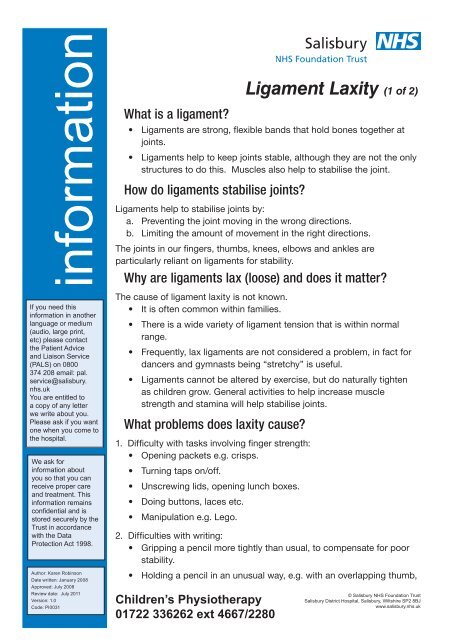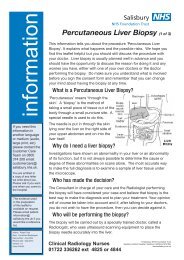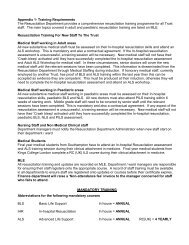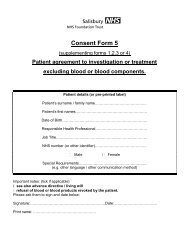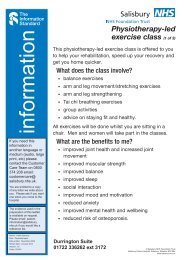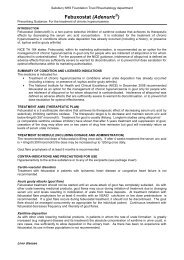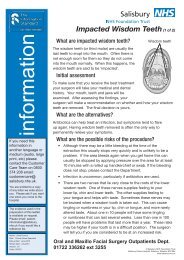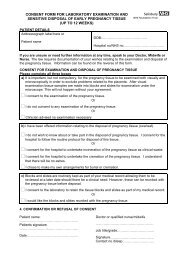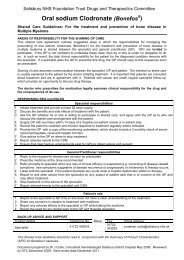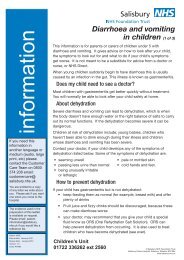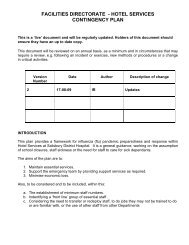Ligament Laxity (1 of 2) - ICID - Salisbury NHS Foundation Trust
Ligament Laxity (1 of 2) - ICID - Salisbury NHS Foundation Trust
Ligament Laxity (1 of 2) - ICID - Salisbury NHS Foundation Trust
Create successful ePaper yourself
Turn your PDF publications into a flip-book with our unique Google optimized e-Paper software.
information<br />
If you need this<br />
information in another<br />
language or medium<br />
(audio, large print,<br />
etc) please contact<br />
the Patient Advice<br />
and Liaison Service<br />
(PALS) on 0800<br />
374 208 email: pal.<br />
service@salisbury.<br />
nhs.uk<br />
You are entitled to<br />
a copy <strong>of</strong> any letter<br />
we write about you.<br />
Please ask if you want<br />
one when you come to<br />
the hospital.<br />
We ask for<br />
information about<br />
you so that you can<br />
receive proper care<br />
and treatment. This<br />
information remains<br />
confidential and is<br />
stored securely by the<br />
<strong>Trust</strong> in accordance<br />
with the Data<br />
Protection Act 1998.<br />
Author: Karen Robinson<br />
Date written: January 2008<br />
Approved: July 2008<br />
Review date: July 2011<br />
Version: 1.0<br />
Code: PI0031<br />
What is a ligament?<br />
<strong>Ligament</strong> <strong>Laxity</strong> (1 <strong>of</strong> 2)<br />
• <strong>Ligament</strong>s are strong, flexible bands that hold bones together at<br />
joints.<br />
• <strong>Ligament</strong>s help to keep joints stable, although they are not the only<br />
structures to do this. Muscles also help to stabilise the joint.<br />
How do ligaments stabilise joints?<br />
<strong>Ligament</strong>s help to stabilise joints by:<br />
a. Preventing the joint moving in the wrong directions.<br />
b. Limiting the amount <strong>of</strong> movement in the right directions.<br />
The joints in our fingers, thumbs, knees, elbows and ankles are<br />
particularly reliant on ligaments for stability.<br />
Why are ligaments lax (loose) and does it matter?<br />
The cause <strong>of</strong> ligament laxity is not known.<br />
• It is <strong>of</strong>ten common within families.<br />
• There is a wide variety <strong>of</strong> ligament tension that is within normal<br />
range.<br />
• Frequently, lax ligaments are not considered a problem, in fact for<br />
dancers and gymnasts being “stretchy” is useful.<br />
• <strong>Ligament</strong>s cannot be altered by exercise, but do naturally tighten<br />
as children grow. General activities to help increase muscle<br />
strength and stamina will help stabilise joints.<br />
What problems does laxity cause?<br />
1. Difficulty with tasks involving finger strength:<br />
• Opening packets e.g. crisps.<br />
• Turning taps on/<strong>of</strong>f.<br />
• Unscrewing lids, opening lunch boxes.<br />
• Doing buttons, laces etc.<br />
• Manipulation e.g. Lego.<br />
2. Difficulties with writing:<br />
• Gripping a pencil more tightly than usual, to compensate for poor<br />
stability.<br />
• Holding a pencil in an unusual way, e.g. with an overlapping thumb,<br />
Children’s Physiotherapy<br />
01722 336262 ext 4667/2280<br />
© <strong>Salisbury</strong> <strong>NHS</strong> <strong>Foundation</strong> <strong>Trust</strong><br />
<strong>Salisbury</strong> District Hospital, <strong>Salisbury</strong>, Wiltshire SP2 8BJ<br />
www.salisbury.nhs.uk
with joints <strong>of</strong> the fingers pushed back excessively and with more <strong>of</strong> the fingers in<br />
contact with the pencil.<br />
• Pressing excessively hard onto the paper.<br />
Although these strategies seem to help stability they hinder fluency and cause poor<br />
blood flow through the muscles, resulting in cramps and pain.<br />
• Poor sitting position when writing.<br />
3. Difficulties with activities that involve walking, standing on one leg or balancing generally.<br />
Children who have underdeveloped foot arches due to ligament laxity <strong>of</strong>ten find it difficult<br />
to stand on one leg and can find sport involving balancing on one leg difficult.<br />
Where arches are well developed, the weight <strong>of</strong> the body is taken through the outer border<br />
<strong>of</strong> the foot and the muscles and ligaments are correctly aligned to control balance. If the<br />
weight is taken through the inner border <strong>of</strong> the foot because <strong>of</strong> ligament laxity, the muscles<br />
and ligaments are poorly aligned, making it more difficult to balance. This can cause foot<br />
and calf pain and minor repetitive injury.<br />
What can be done to improve function?<br />
Using insoles to correct the foot position may limit the pain and may help increase stability.<br />
Activities that gently increase stamina and muscle strength should be incorporated into<br />
everyday activities, such as:<br />
Gross motor activities<br />
1. Playing in the park and indoor s<strong>of</strong>t play.<br />
2. Swimming.<br />
3. Walking.<br />
4. Playing non-competitive ball games.<br />
<strong>Ligament</strong> <strong>Laxity</strong> (2 <strong>of</strong> 2)<br />
Fine Motor activities<br />
1. Using different width pens to help improve hand position when writing and reduce pain<br />
(you can use an elastic band to widen a pen or pencil). If the child is overusing certain<br />
muscles, and this is causing pain, they can benefit from massage and stretching, which<br />
improves blood flow. Short rests and stretching whilst working can help.<br />
2. Playing with Lego, Play Dough, model making etc. will increase finger strength.<br />
3. A sloped writing board and a sloped cushion to sit on can help improve a sitting<br />
position.<br />
4. When using computers; short rests and stretching whilst working helps.<br />
If you have any specific concerns regarding the above information, please contact your<br />
child’s therapist on telephone number below.<br />
Many thanks to Sally Wright who allowed us to base this information sheet on one that she<br />
had produced.<br />
Children’s Physiotherapy<br />
01722 336262 ext 4667/2280<br />
© <strong>Salisbury</strong> <strong>NHS</strong> <strong>Foundation</strong> <strong>Trust</strong><br />
<strong>Salisbury</strong> District Hospital, <strong>Salisbury</strong>, Wiltshire SP2 8BJ<br />
www.salisbury.nhs.uk


